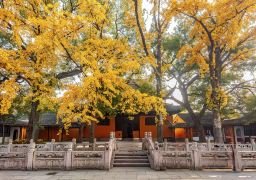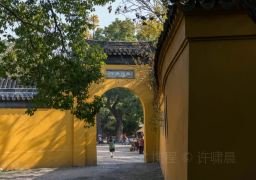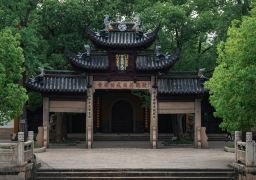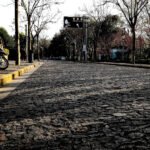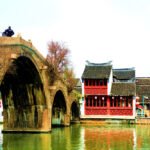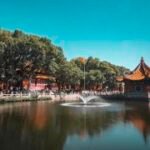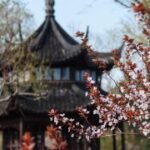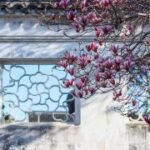Xiyuan Temple, known by many names, is marked as ‘Jie Zhuang Lu Si’, ‘Xi Yuan Gu Sha’, and ‘Xi Yuan’ on Baidu or Google Maps, all referring to the same location. The temple was originally built during the Yuan Dynasty’s Zhiyuan period (A.D. 1264-1294), originally named Guiyuan Temple, and the existing structures were rebuilt during the Qing Dynasty. During the Ming Dynasty’s Jiajing era, it was temporarily converted into a private garden by Xu Tai, the creator of the Liuyuan and a Minister of the Imperial Stud. Today, Xiyuan Temple serves as a temple garden within Suzhou city, featuring an architectural style that combines temple and garden elements, likely influenced by the Ming Dynasty. The main temple buildings are aligned along a north-south central axis, which can be visited sequentially. South of the temple, there is a screen wall inscribed with ‘Jie Zhuang Lu Si’, and to the north of the wall, the Fude Bridge and Zhihui Bridge span the Shangtang River side by side. On the opposite bank stands an imperial plaque inscribed with ‘Imperially Bestowed Xiyuan Jie Zhuang Lu Si’, with the vertical plaque ‘Zhen Guo Jie Zhuang’ at the top center, a gift from Emperor Guangxu of the Qing Dynasty. North of the imperial plaque is the mountain gate; upon entering, one is within the temple grounds. A large square filled with pine and cypress trees greets visitors. Xiyuan Temple is home to many ancient trees, including camphor and ginkgo trees that are over a hundred years old. Following the corridor northward, one finds the bell tower to the east and the drum tower to the west. Beyond the corridor stands the Mahavira Hall. The Sanbao Building at the northern end, which houses the sutras, is not open to the public. To the east of the Mahavira Hall is the Guanyin Hall, and the Hall of Five Hundred Arhats to the west is a noteworthy structure within the temple. It contains five hundred gilded Qing Dynasty arhat statues, each with unique shapes. After paying homage to the 13-meter tall Thousand-Armed Guanyin carved from camphor wood in the center of the hall, one can participate in the distinctive activity of ‘counting the arhats’. Men start from the left and women from the right, choosing a statue that appeals to them and counting to their age in years, stopping at the statue that corresponds to their current age, which is believed to represent their current life. Remember the arhat’s number and obtain a corresponding arhat card at the entrance of the arhat hall, which comes with an annotated fortune. To the south of the arhat hall stands a statue of Ji Gong, and to the north, a statue of a mad monk. The robes and folds of both statues appear lifelike, rumored to be the competitive works of the two lead sculptors who created the Five Hundred Arhats. Moving further west, the western part of the temple, known as Xiyuan Garden, is another highlight. This area is rich in Suzhou garden style, with a tadpole-shaped release pond at the center, head facing south and tail facing north, extending towards the southeast, leading the pond water around the garden and directly to the Xiangji Pond in front of the Mahavira Hall, echoing the architectural characteristic of water features in Jiangnan gardens. In the middle of the lake is the Lake Heart Pavilion, surrounded by rockeries and pavilions, making the area hardly recognizable as a temple. The two Ming Dynasty softshell turtles, over 400 years old, in the release pond have always been a popular topic among visitors. These turtles are extremely rare, with only a few existing in the world.
Unfortunately, one of the giant softshell turtles passed away in 2007. Visitors who cannot see the real turtle can take a photo with a bronze statue of it located at the southwest corner of the Release Pond to make up for the regret. On the east side of the pond, the ‘Four-Sided Pavilion’ serves as a place for Buddhist merchandise, where one can purchase prayer beads and other Buddhist souvenirs. The terrace of the pavilion is adorned with two Ming Dynasty wisteria trees, over 400 years old, and to the south, there is an even older wisteria tree, more than 500 years old. The Dharma Propagation Department to the south of Xiyuan offers free Buddhist scripture booklets. Xiyuan Temple is renowned among locals in Suzhou for its efficacy in fulfilling wishes, making it an ideal place for prayer. On the first and fifteenth days of the lunar month, the temple is visited by a constant stream of worshippers; during the Spring Festival, the temple’s incense is particularly strong, with many worshippers rushing to burn incense on the first day of the lunar year. On the birthdays and anniversaries of various bodhisattvas, the temple also holds Dharma assemblies. Inside the temple, there is a vegetarian restaurant located to the west of the Hall of the Heavenly Kings and to the south of the Hall of Five Hundred Arhats. They offer only three types of noodles: Ruyi Noodles, Arhat Vegetarian Noodles, and Guanyin Noodles, all priced at just 10 yuan per person. Outside the temple, there is a merit forest with a long-standing vegetarian restaurant, where the prices are slightly higher than those inside the temple, but the vegetarian chicken and ‘sweet and sour pork ribs’ are particularly delicious. To the west of Xiyuan Temple lies Hanshan Temple, to the east is Lingering Garden, and to the north are Dingyuan and Tiger Hill, allowing visitors to plan their sightseeing routes according to their preferences. The temple is open all year round from 08:00 to 17:00. Preferential policies include free admission for children under 6 years old (inclusive) or under 1.4 meters (inclusive) in height with valid identification, half-price tickets for minors aged 6 to 18 years old, full-time undergraduate students and below, and seniors aged 60 to 70 years old (inclusive) with valid identification (please purchase preferential tickets at the scenic spot), free admission for seniors aged 70 years old (inclusive) and above with valid identification, free admission for active duty military personnel and retired military officers of the People’s Republic of China with valid identification, and free admission for the disabled and one accompanying caregiver for severely disabled individuals with valid identification. Note: The above information is for reference only; specifics are subject to the public notice at the scenic spot.

